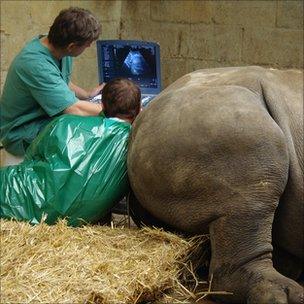How to artificially inseminate a rhino
- Published
How to artificially inseminate a rhino - vet Tim Bouts reveals all
An assortment of specialist scanners, probes and other paraphernalia are carefully laid out, ready for action.
But unlike the kit used for most medical procedures, everything here is on a supersized scale.
The reason? Scientists are about to examine two southern white rhinos at ZSL Whipsnade Zoo, external in Bedfordshire.
Their job today is to help them conceive through artificial insemination, a procedure that entails collecting the semen from the male rhino and then inserting it into the female.
Tim Bouts, the zoo's veterinary officer, explains that natural conception is not an option for the female rhino.
She has sustained an injury to her foot, and if a male attempts to mount her, it could cause her serious damage.

The researchers carrying out the procedure are the world experts in rhino reproduction
But Dr Bouts explains that the zoo is keen to boost numbers of this species.
In the wild, southern white rhinos have suffered devastating hits to their population thanks to a recent surge in poaching.
In South Africa, once a stronghold for this species, hundreds of rhinos have been slaughtered by organised gangs, their horns sold in Asia and the Middle East where they are used for medicine and ornaments.
Dr Bouts says that trying to ensure that there is a healthy population in captivity is key.
"There are not that many southern white rhinos in our zoos, and at this point, the population is not yet self-sustaining, so every rhino baby is actually very important," he explains.
Assisted reproduction in rhinos is a relatively new technique - it first took place in Hungary in 2006 - but is now being used more and more.
And the team from the Leibniz Institute for Zoo and Wildlife Research , external (IZW) in Germany that pioneered the procedure are here to help with this rhino pair.
Thomas Hildebrandt, Robert Hermes and Joseph Saragusty are something of a reproductive hit squad - flying all around the world to help animals conceive.
It is an unusual job, but it has taken a great deal of research to work out how to successfully perform artificial insemination on animals like rhinos.
Dr Hermes explains: "There are lots of aspects that we need to get a conception, and the access we have to these wild animals is so limited, so we needed a long time to put all the different pieces of the puzzle together.
"So we now know when the ovulation takes place, we know how to obtain the semen, and on top of that, we know the anatomy and the tools necessary to do an insemination, which is very specific for rhinos."
'Electro-ejaculator'
The procedure at Whipsnade takes place over a few hours. The scientists are kitted out in plastic overalls - it is a messy job.
First of all, the male is anaesthetised, and after various checks are carried out, the team uses an "electro-ejaculator", which is inserted into the rhino's rectum to cause it to produce semen that the researchers can then collect.
After the sperm is checked under the microscope to ensure it is healthy, the female, which has been on hormone treatment to make sure she is ovulating, is then sedated too.
The team uses sophisticated 3D-ultrasounds to monitor her reproductive system, and then - when everything is ready - inserts the sperm using a probe.
As well as perfecting this method, the German team has now also taken rhino reproduction even further: they have used frozen sperm in artificial insemination and at Western Plains Zoo in Australia, they have created a rhino embryo using in vitro fertilization (IVF), although the embryo has not been transferred back into a female.

The northern white rhino is one of the world's most endangered species with only seven alive
And the technology is also developing apace around the world.
A recent paper, external in Nature Methods reported that scientists had created stem cells from northern white rhinos - the most endangered rhino in the world, with just a handful left in existence. The researchers say that one day these cells could be turned into sperm and egg cells to bring the species back from the brink.
And projects like Ibream, external are also looking at the possibility of cloning rhinos, as a weapon of last resort if this species plummets further.
While this technology is still a long way off, Dr Hermes says that for now, assisted reproduction is increasingly being looked at as a conservation strategy.
"What you can see with the [poaching] development in South Africa is situations may change very quickly, from where you think you have saved a species and they are in a safe haven to a few years later where they are being taken out by the hundreds," he says.
"And if that is the case, it is always good to have all the necessary tools in hand and that is why we think assisted reproduction does make sense.
"Because if you do need to use it, it doesn't just fall out of the sky, it needs preparation, development and a lot of knowledge."
With the procedure complete, and the rhinos waking up sleepy from the anaesthetic - the scientists are now in for a tense wait.
For the next few weeks, the female's hormones will be carefully monitored to see if she is pregnant.
And if she is, and all goes to plan, in 16 months' time these researchers can say they have successfully played a part in adding another rhino to this endangered population.
- Published4 September 2011
- Published29 October 2010
- Published20 August 2011
- Published11 July 2011
- Published25 March 2011